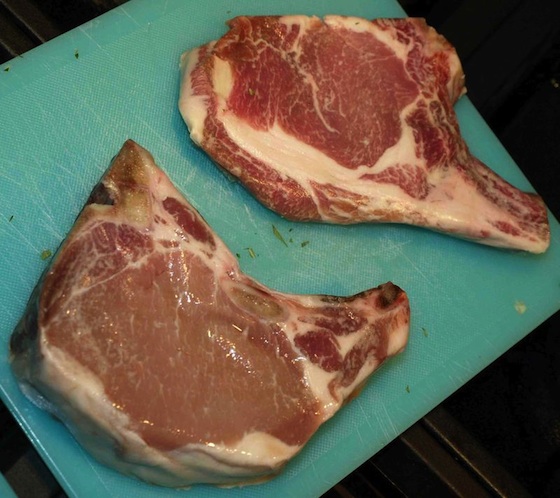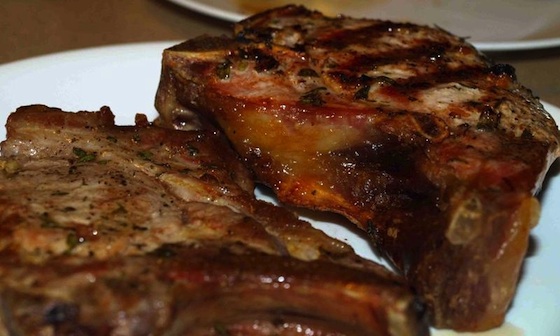Question: When is the last time you have seen hunks of pork quite like this:
One does not usually couple the term “marbling” with pork, but look at them. Look. At. Them. Especially the porterhouse pictured at the top. Marbling. It makes The Hack want to sing.
Commodity pork, for the last 20 plus years (at least) has been bred to be lean, so the pork industry could sell it as “The Other White Meat.” Lean meat means lean flavor, and a tendency to dry out during the cooking process.
But heritage breed piggies are bred to be…well, pigs. They eat like pigs eat, muck around and get a little rotund in the process. Names out there include Gloucestershire and Tamworth, and perhaps the most commonly known is Berkshire. Another breed rising in popularity is Duroc, and one of the leaders in producing them is the Minnesota-based Compart Family Farms.
The Hack will let readers discover all the details about that company from its Web site, and cut to the chase. For his day job, The Hack in June wrote about meat being increasingly—and unashamedly—featured in all forms on restaurant menus thanks in part to the resurgence of age-old preparation and preservation methods. Part of the article included Compart’s dry-aged pork. It’s the first company to dry age pork in the country, possible because the Duroc breed has enough marbling to allow the natural tenderizing process to occur.
While the Hack wrote the story, Bill Norton, a fine Compart fella, dropped these fine cryovac-ed samples for him at the office. The Hack didn’t have a chance to cook them before the article ran, but oh, he certainly made the time afterward—a perfect debut for Test Kitchen Chronicles.
Because the meat can be cooked like beef—read rare—it was suggested to The Hack by FireLake Grill house and Radisson Hotel Executive Chef Paul Lynch to not do too much to the meat. Just enjoy the flavor. His directions:
“When you get home, please cook it over charcoal, don’t use a gas grill. Simply crush garlic and some chopped rosemary—if you have some Montreal steak spice, put olive oil rosemary and garlic together, rub it on the steak, sprinkle on some Montreal steak spice. If you want to give it another layer of flavor, it does benefit from a little quick rub—as I think all steaks do—with soy sauce because it provides that outer caramelization that gives you just that touch of umami.
“So when you first get your grill hot, rub (the steaks) with soy sauce, let them sit for four or five minutes, then rub it with the garlic, olive oil, rosemary, and a sprinkle of Montreal spice, and you are going to be in for a piece of heaven.”
That’s it. The Hack followed those directions precisely, although, in place of Montreal spice mix, he used Kosher salt and pepper. The soy sauce is a nice trick: The Hack agrees fully it gives grilled meat just a little something extra that folks don’t quite grasp, but know something is going on. It’s also a reason to use less salt. But, like a good hunk of beef, this-dry aged pork stands up well to seasoning.
The Hack fired some natural hardwood charcoal in his chimney starter, dumped a load into his wood grill/smoker, let the grill heat up and slapped cooked the pork. Again, cook it as one would steak. A few minutes a side, and done. (The Hack prefers medium rare, his better half medium, but he kept it more to his liking.)
Never prone to effusive praise, The Hack was nonetheless more than slightly blown away by the texture and vibrant flavor of his dry-aged pork porterhouse and chop. The meat was half devoured before being plated with the rest of the meal. The porterhouse, as expected, had a richer flavor, but the chop was, as chops go, at the top of the heap that The Hack has cooked and consumed.
Order up, and enjoy.



1 comment for “TKC: Dry-aged pork. Really!”